This article on the Cmaj7 chord will cover the notes, intervals, associated scales and modes, patterns on the fretboard, CAGED patterns, open, movable, and Barre patterns, piano note layouts, inversions, fingering, etc.
Read the complete article below to know all this!
Music Theory, Notes & Intervals of the CMaj7 Chord
The CMaj7 chords are also known as the “C Major 7 Chord” and “C Major 7th Chord.” These are formed by stacking a major third interval over a major triad. We have covered their detailed music theory, notes, and intervals in our articles on the Seventh Chords and the Major 7 Chords.
The CMaj7 chords have three intervals – Major Third, minor third, followed by another Major third, or R – M3 – m3 – M3, where R denotes the root note.
The C Major triad is the tonic chord of the C Major scale with notes [C E G]. The CMaj7 has an additional major seventh interval leading to the four notes with the note names [C E G B].
C Major 7 Chord Scales
The C Major chord naturally occurs in
- The C major scale as the tonic chord.
- The G major scale as the subdominant chord.
- The relative minors of the above scales – are ‘A’ (Mediant Chord) and E Minor Scales (Submediant Chord).
- All the modes of the C Major Key.
How to Use C Major 7 Chords
The Major7 chords naturally occur on the 1st and the 4th scale degrees of the major scale. Seventh chords are normally built to add tension when you are approaching the tonic. Hence the IV7 chord is more commonly used as the Major seventh chord.
How To Play the C Major 7 chord
Next, we will discuss how to play these chords on the guitar and the piano keyboard.
CMaj7 Chord Guitar
We shall look at the chord positions on the guitar fretboard, primarily using the CAGED system, and then add a few movable and Barre chords to form a complete repertoire. You can refer to our complete article on the C Major scale to know the details of the layout of the CAGED patterns for the scale, which will form the basis of the layout of these chords.
Map Chords Along All The Fretboard
Before we dive deep into the positions of the guitar chords, let us look at how the CMaj7 guitar chord tones are spread out on the different strings of the fretboard in one octave and a few frets further. The root notes are shown in orange color.
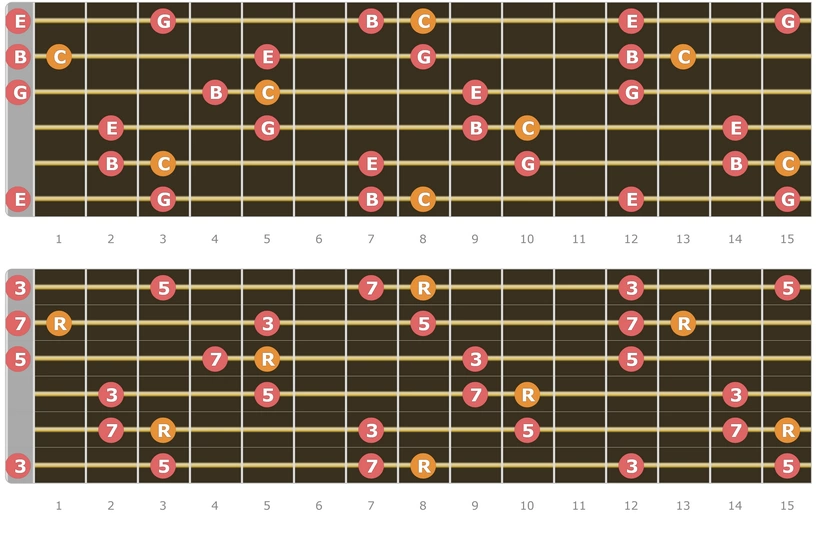
C Major Seventh Chord – Guitar Chord Shapes and Fingerings
As stated earlier, let us now start looking at the individual chord diagrams based on the 5 different Open Chord shapes C, A, G, E, and D. As you may the system is equally applicable for the minor chords.
C Open Chord Shapes
As the C shape for the C major scale is nearest to the nut, you will get the maximum open positions from this shape. These are shown in the diagrams below as C1, C2, and C3.
C1
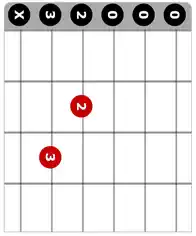
C2
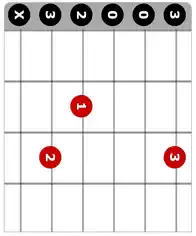
C3
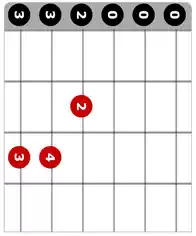
The numbers shown in the black circle are the fret numbers. The zero represents that the corresponding string has to be played in an open position. While an X means that the string should not be played at all or muted.
The numbers in red circles denote the fret to be played along with the corresponding finger number. The 1 denotes the index finger, 2 the middle finger, 3 the ring finger, and 4 the little finger.
You require only two fingers to play C1 and three fingers for C2 and C3.
‘A’ Open Chord Shapes
You can play A1, A2, and A3 patterns shown in the chord diagrams below in the open positions. A1 uses two fingers, A2 three, and A3 needs four fingers.
A1
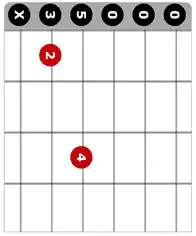
A2
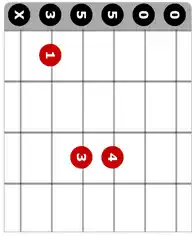
A3
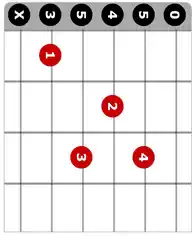
A Movable and Barre Chord Shapes.
The A4 and A5 voicings show the movable and the Barre chord versions of the C Major 7 chords. You can move down these shapes along the fretboard to get different Major 7 chords.
A4
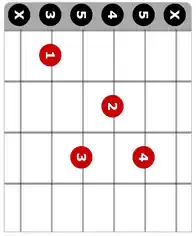
A5
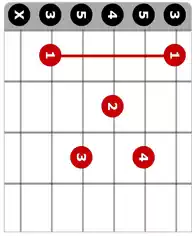
G Barre Chord Shapes
The G1 Barre chord shape is shown below.
G1
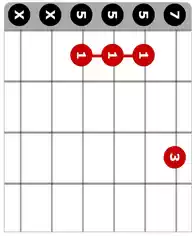
E Open Chord Shapes
The E3 diagram shows the open position E Shape below.
E3
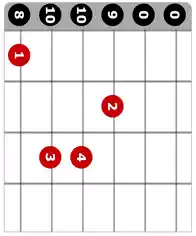
E Movable and Barre Chord Shapes
The E1 and E2 diagrams below show the different types of movable shapes, while E4 is the Barre shape based on the E open chord shape. The E1 movable shape has an omitted 5th-degree voicing.
E1
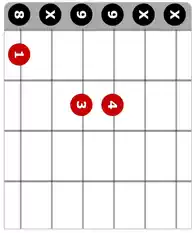
E2
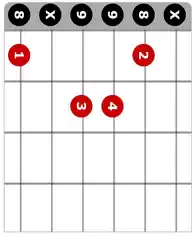
E4
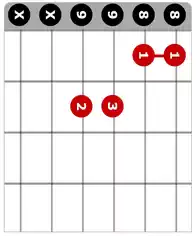
D Movable and Barre Chord Shapes
As the D shape pattern is located lower down the fretboard for the C Major scale, it has only the movable (D1) and Barre patterns (D2), shown below.
D1
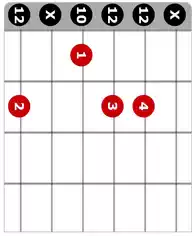
D2
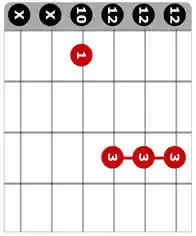
Other Movable Patterns
The chord diagrams below show two other movable Patterns, M1 and M2.
M1
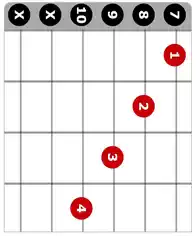
M2
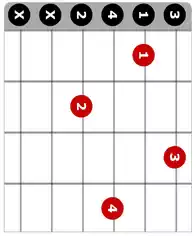
Inversion of the CMaj7 Chord
As the CMaj7 chord has four notes, it has three chord inversions, as shown below.
- First Inversion CMaj(6/5) with notes [E G B C]. The Bass note is E.
- Second Inversion CMaj(4/3) with notes [G B C E]. The lowest note is G
- Third Inversion CMaj(4/2) with notes [B C E G]. The Bass note is B.
Chord Diagrams – Cmaj7 chord inversions
The chord diagrams for the inversions of the C Major 7 chords are shown below as I1, I2, and I3, where I1 is the first inversion, I2 the second, and I3 the third inversion.
I1
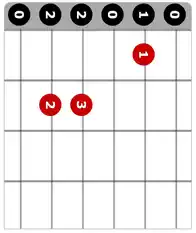
I2
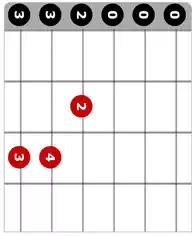
I3
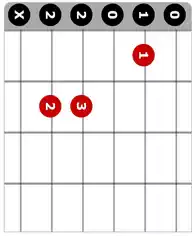
CMaj7 Chord Piano
Let us now look at the C Major 7 Chord for Piano, its layout on the keyboard, inversions, and the fingerings.
CMaj7 Chord for Piano with Keyboard Diagram.
The keyboard diagram with the notes of the CMaj7 chord marked in red on the required keys is shown below.

Fingerings – Left Hand
To play it with your left hand, you need the fingering pattern 5 – 3 – 2 – 1, where 5 is the little finger and 1 is the thumb. So use,
- Left Little finger for note C.
- Left Middle finger for the note E.
- Left Index Finger for note G.
- Left thumb for note B.
Fingerings – Right Hand
If you want to use your right hand to play the chord, use the fingers 1 – 2 – 3 – 5, The numbering system for both hands is the same. The thumb is always called 1. So use,
- Right for note C.
- Right Index Finger for the note E.
- Right Middle Finger for note G.
- Right Little Finger for note B.
Piano Chords in Inversions with Fingerings
Let us now have a look at the inversions of CMaj7. We have already discussed their notes above. The diagrams and their fingerings are.
First Inversion
The keyboard diagram for the CMaj7/E, the first inversion, is shown below.

The fingering arrangement for the 1st inversion is
- Right Hand – 1 – 2 – 4 – 5.
- Left Hand – 5 – 3 – 2 – 1
Second Inversion
The keyboard diagram for the CMaj7/G, the second inversion, is shown below.

The fingering arrangement for the 2nd inversion is
- Right Hand – 1 – 2 – 3 – 5.
- Left Hand – 5 – 3 – 2 – 1
Third Inversion
The keyboard diagram for the CMaj7/B, the third position (inversion), is shown below.

The fingering arrangement for the 3rd inversion is
- Right Hand – 1 – 2 – 3 – 5.
- Left Hand – 5 – 4 – 2 – 1
Conclusion
We hope that this article on playing the CMaj7 chord on guitar and piano has been useful to you. If you have any doubts, feel free to comment in the section below.

